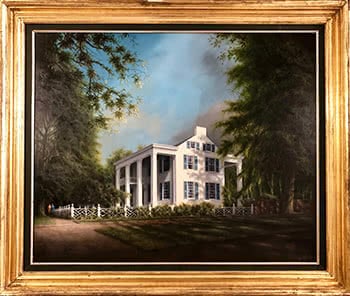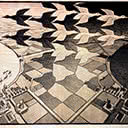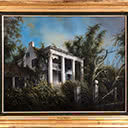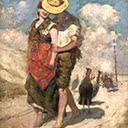Washington Moody House
66 x 81 cm
est. $15,000 - 20,000
Original Kennedy Galleries, Inc. label affixed verso
Provenance:
Commissioned by the late Jack Warner, Gulf States Paper Corporation Collection Private Collection, Alabama, USA
The Moody-Warner House was built around 1822 by Alabama merchant Davis Scott as his Tuscaloosa home.
The house had a series of owners until it became the home of the Washington Moodys. Moody was the grandson of the founder of the First National Bank.
The house was restored in 1977 by art collector Jack Warner and eventually became a museum named in honour of Jack Warner's mother, Mildred Grace Westervelt Warner (1893-1974).
The museum closed and the house was put up for sale in 2003.
American architect, philanthropist and art collector Jack Westervelt Warner was born in Illinois in 1917. The family moved to Tuscaloosa, Alabama when his grandfather Herbert E. Westervelt consolidated Alabama's first modern pulp and paper mill in 1929.
For nearly 50 years Jack Warner presided over Gulf States Paper Corporation, creating a quality leader in the American paper industry. He expanded operations from a single product and a single plant, creating a large, diversified company with operations in timber, lumber, wood pulp, paperboard, moulded wood products and folding cartons spread across five states. Along the way, the company garnered environmental protection awards from the National Wildlife Federation, the American Paper Institute and the Environmental Protection Agency.
Jonathan 'Jack' Westervelt Warner created one of the premiere collections of American art in the world today. As the third generation CEO of his family company, Gulf States Paper Corporation, Jack began collecting in the 1950's with his first Audubon prints. Over 400 masterpieces eventually found their way into his collection. Masterpiece paintings, furniture, sculptures and decorative arts from the late 1700's to the early 1900's attested to his discerning eye for quality.
A veteran of WWII and an expert horseman, Jack's collection expresses his passion for life and his passion for America. Warner's own artistic creativity is on display in the permanently unfinished four acre garden surrounding his nearby home on the shores of North River Lake, Whispering Cliffs. He designs it continuously, and has a crew working on it daily. The many waterfalls and planted dead trees suggest it is his own personal Hudson River landscape painting.
In walking through the garden in March one is impressed by the fact that it is as he describes it: an all season garden. He believes one can find God in a leaf, a flower and a landscape. Warner was well known for his generous philanthropy to many causes including the University of Alabama as well as Auburn University, Culver Military Academy, Washington and Lee University, the First Presbyterian Church, the United Way and the City of Tuscaloosa, where he built community swimming pools and provided programs for many underprivileged children to receive swimming and water safety lessons as well as art and history education at his Westervelt Warner Museum of American Art.
Felix Kelly is one of New Zealand's most interesting expatriate artists. Born in Epsom in 1914 he claimed to be two years younger most of his adult life. Kelly studied briefly, and even seems to have taught drafting at Elam School of Fine Art. He was only 21 when he left New Zealand in 1935. He never returned. In London Kelly continued his New Zealand occupation of graphic design, working for Lintas, the advertising wing of Unilevers. He also freelanced as an illustrator and cartoonist, especially for Lilliput. His cartoons are not unlike those of the slightly younger Ronald Searle. After the war and the RAF, the focus of his graphic art shifted to book illustration, dust-jacket design and contributions on interior decoration to such fashion magazines as Ideal Home and Harper's Bazaar. In the 1950s and 60s he was acknowledged as one of England's top designers for the theatre, working with the likes of Sir John Gielgud and Dame Sybil Thorndike.
Kelly's ambition had always been to succeed as a painter. Emerging in the context of Surrealism and British Neo-Romanticism, he exhibited alongside important British artists such as Lucian Freud, John Piper and fellow New Zealander Frances Hodgkins. He attracted the attention of the prominent critic and writer, Herbert Read. Kelly's paintings are characterised by his interest in a world forgotten by progress, great houses falling into dilapidation, wind- blasted trees, abandoned locomotives often invested with an eerie watchfulness. Rapidly, Kelly assembled a client list resembling a page from Who's Who or De Brett's. In late career, his knowledge of architecture led to involvement in house design, most notably his collaboration on the redesign of Highgrove for the Prince of Wales.
His most celebrated project was, however, the mural cycle at Castle Howard associated with the filming of Brideshead Revisited in the 1980s. Kelly travelled a great deal. Paintings of Spain and Italy in the 1940s were followed by West African scenes in the 50s and ante-bellum houses in America's Deep South in the 60s and 70s. Trips to Russia, Thailand, India and Egypt in the 70s and 80s each led to an exhibition of exotic paintings. In late career, Kelly would execute a small sketch characterised by loose brush-work, which would then be converted into a carefully executed big-scale painting. Both types of work appear for sale from time to time. Kelly completed paintings of Auckland subjects done decades after he had left home. Auckland's West Coast beaches or Takapuna with Rangitoto beyond, or paddle-steamers on the Waitemata, were evoked with an increasing degree of fantasy well into the 1960s. A quirky humour pervades his work.
Felix Kelly has to be one of New Zealand's most individual artistic exports. A comprehensive exhibition of his earlier work, curated by Donald Bassett and mounted by the Hawke's Bay Museum and Art Gallery, toured several New Zealand centres in 2008- 9. A second edition of Donald Bassett's book Fix; The Art and Life of Felix Kelly, was published in 2013.





